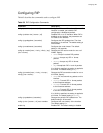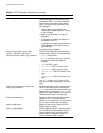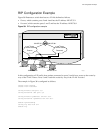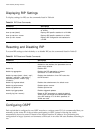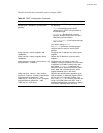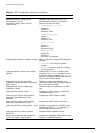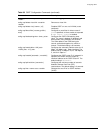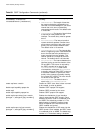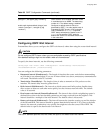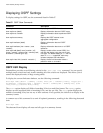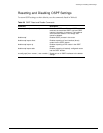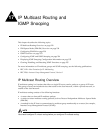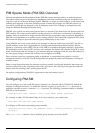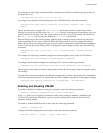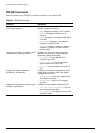
Configuring OSPF
Summit 200 Series Switch Installation and User Guide 225
Configuring OSPF Wait Interval
ExtremeWare allows you to configure the OSPF wait interval, rather than using the router dead interval.
CAUTION
Do not configure OSPF timers unless you are comfortable exceeding OSPF specifications.
Non-standard settings might not be reliable under all circumstances.
To specify the timer intervals, use the following command:
config ospf vlan <vlan> timer <rxmtinterval> <transitdelay> <hellointerval>
<routerdeadinterval> [<waitinterval
>]
You can configure the following parameters:
• Retransmit interval (RxmtInterval)—The length of time that the router waits before retransmitting
an LSA that is not acknowledged. If you set an interval that is too short, unnecessary retransmissions
will result. The default value is 5 seconds.
• Transit delay (TransitDelay)—The length of time it takes to transmit an LSA packet over the
interface. The transit delay must be greater than 0.
• Hello interval (HelloInterval)—The interval at which routers send hello packets. Smaller times
allow routers to discover each other more quickly, but also increase network traffic. The default
value is 10 seconds.
• Dead router wait interval (RouterDeadInterval)—The interval after which a neighboring router is
declared down due to the fact that hello packets are no longer received from the neighbor. This
interval should be a multiple of the hello interval. The default value is 40 seconds.
• Router wait interval (WaitInterval)—The interval between the interface coming up and the election
of the DR and BDR. This interval should be greater than the hello interval. If it is close to the hello
interval, the network synchronizes very quickly, but might not elect the correct DR or BDR. The
default value is equal to the dead router wait interval.
NOTE
The OSPF standard specifies that wait times are equal to the dead router wait interval.
enable ospf export static [cost <metric>
[ase-type-1 | ase-type-2] {tag <number>}]
Enables the distribution of static routes into the
OSPF domain. Once enabled, the OSPF router
is considered to be an ASBR. The default tag
number is 0. The default setting is disabled.
enable ospf originate-default {always} cost
<metric> [ase-type-1 | ase-type-2] {tag
<number>}
Configures a default external LSA to be
generated by OSPF, if no other default route is
originated by OSPF by way of RIP and static
route re-distribution. If always is specified,
OSPF always advertises the default route. If
always is not specified, OSPF adds the
default LSA if there is a reachable default route
in the route table.
Table 66: OSPF Configuration Commands (continued)
Command Description



